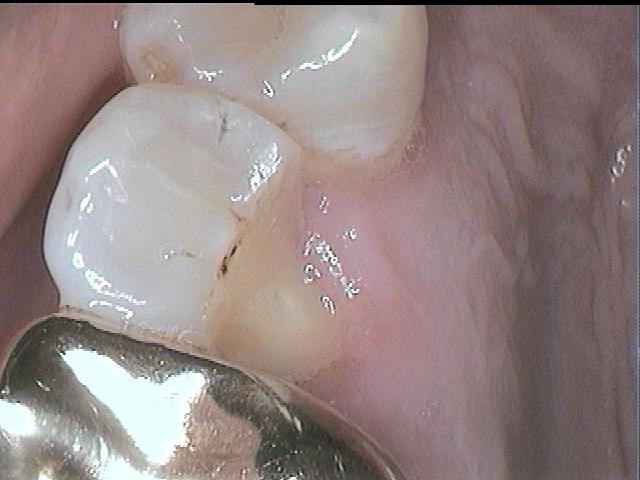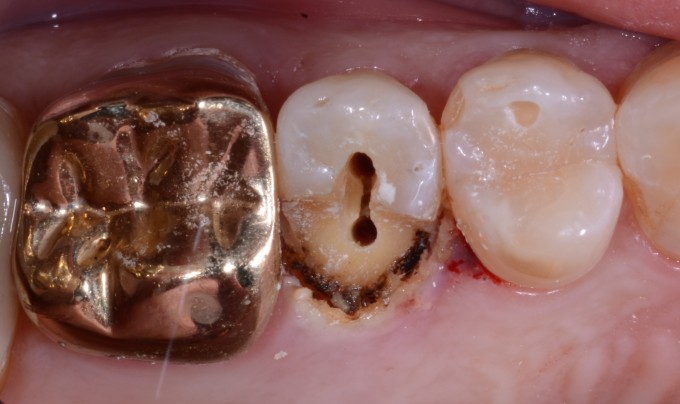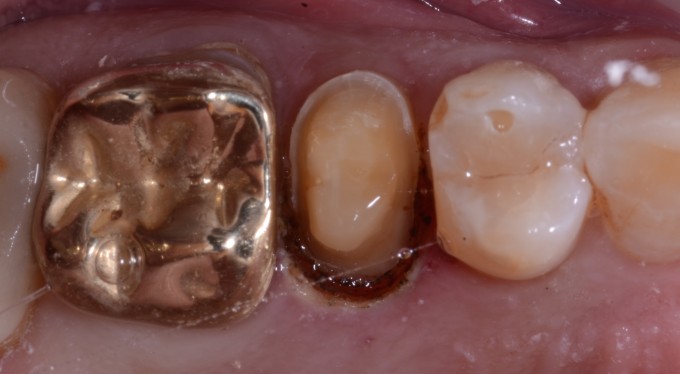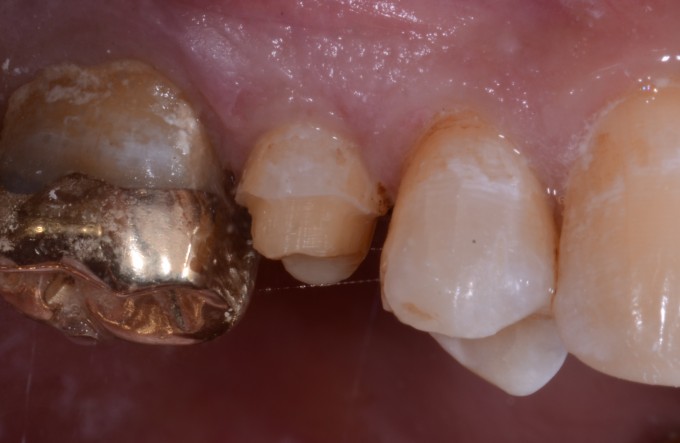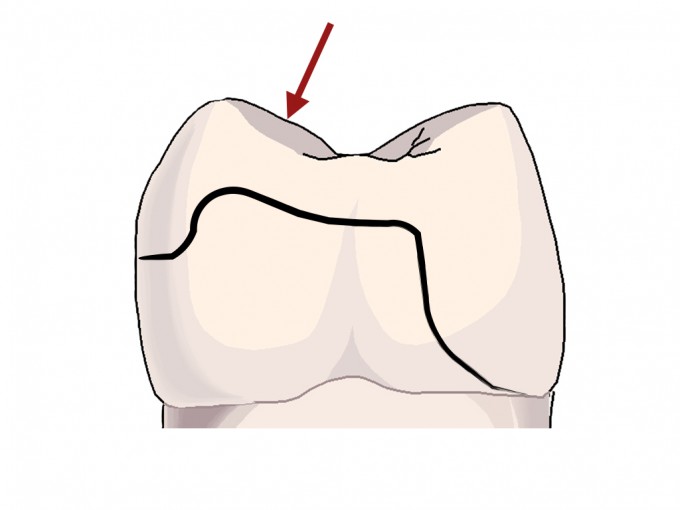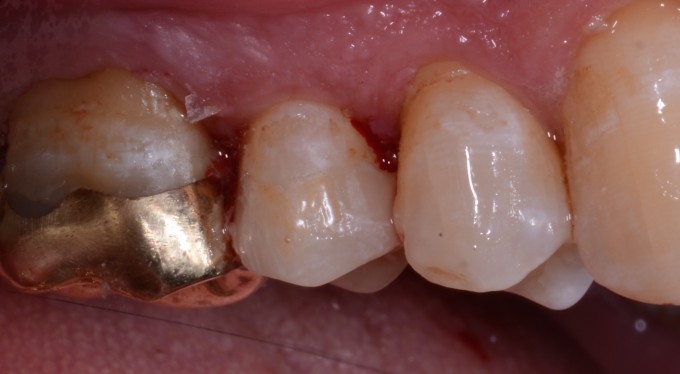The esthetic bevel to the rescue!
The esthetic bevel has been talked about numerous times on the forums from the stand point of being conservative and allowing restorations to blend in to the remaining structure. But on of the benefits of this conservation of tooth structure is keeping the structural integrity of a compromised tooth. This patient walked called in with an emergency of a fractured tooth. The virgin tooth #13 fractured the lingual cusp below the gingiva.
The options were try and save the tooth or remove and implant. There was still a lot of good tooth structure to work with as long as we didn't mow down the facial aspect. In comes the esthetic bevel. The lingual gingiva was removed with a diode laser to assess how deep the fracture was. Upon exposure and probing it was found a margin could be placed without impinging on the biological width. The root canal was accessed, instrumented and filled.
After this a build was placed and the tooth prepared for full coverage utilizing the esthetic bevel to keep as much of the buccal tooth structure as possible.
When doing a high and dry margin like this on the facial aspect make sure not to make the margin straight across. There is a slight wave to the margin. The eye notices sharp delineations and straight lines. By making the margin smooth but uneven it tricks the eye. To make the bevel either use a football diamond or a large chamfer bur.
Fractures generally occur from working side interferances. Thus buccal cusps on maxillary teeth and lingual cusps on mandibular teeth. By keeping the extra buccal tooth structure we reduce the risk of fracture from excursive movements. This danger to preparing the buccal aspect to the gingiva is weaking the tooth and leading it to fracturing at the gum line making the tooth unrestorable in the future. The extra tooth structure acts as a buttress to fortify the tooth from future fracture.
The material of choice in this situation needs to have enough translucency to allow the bevel to blend in. For this case an A2 MT Emax was used. Care needs to be taken during cementation to prevent staining of the margin. Make sure to etch the enamel for a full 20 seconds. Lack of adequate time with etchant will cause premature break down of the margin. Also allow the bonding agent to have time to penetrate well enough so follow the directions of the manufacturer for the proper length of time to allow it to work it's magic. And finally seat the restoration clean off the excess with a greg 3/4 or similar instrument. Press down firmly on the restoration, you should see a little more material express out. Tack cure if that is your preference or allow it to gel. Clean the interproximals but leave the facial alone. Apply glycerin gel to the margin over the little bit of material left. Do your final cure. Now clean the excess with a fine diamond. This will give you the most protection for the margin and prevent future staining.
Maintaining the extra tooth structure now gives the added strength to the tooth to allow it to have a much better prognosis than if the buccal tooth structure was removed for esthetics.
On 4/19/2017 at 7:41 am, John Daw said...The wave margin really helps to mask the margin on #3 too
I know, you can't even see where the gold starts.
On 4/19/2017 at 7:57 am, Darin O'Bryan said...On 4/19/2017 at 7:41 am, John Daw said...The wave margin really helps to mask the margin on #3 too
I know, you can't even see where the gold starts.
LOL
great job
I would have likely prepped the lingual more traditional and cemented the crown and not even bothered with the bonding.
On 4/19/2017 at 9:20 am, Mike Skramstad said...great job
I would have likely prepped the lingual more traditional and cemented the crown and not even bothered with the bonding.
I have seen first premolar fractures like this more often than you would imagine. I just had one last week--I could not locate the palatal canal and neither could the endodontist. I hated to take that tooth out.
On 4/19/2017 at 9:20 am, Mike Skramstad said...great job
I would have likely prepped the lingual more traditional and cemented the crown and not even bothered with the bonding.
Buccal?
Nice case!
I would raise the palatal flap and place rubber dam for better visulisation. Secondly since it fractured I would prep occlusal flat to reduce the stress to cusps. Gregory
On 4/19/2017 at 9:47 am, Paul Anderson said...On 4/19/2017 at 9:20 am, Mike Skramstad said...great job
I would have likely prepped the lingual more traditional and cemented the crown and not even bothered with the bonding.
Buccal?
yes... my bad. Buccal. You cannot isolate the lingual like that unless you are going to flap like gregory said. Cementable is a better option for me on something like this.
On 4/19/2017 at 9:54 am, Gregory Mark said...Nice case!
I would raise the palatal flap and place rubber dam for better visulisation. Secondly since it fractured I would prep occlusal flat to reduce the stress to cusps. Gregory
I used the laser even more after the prep photo shown and also use retraction paste to reduce sulcular fluid. Visualization and isolation was not an issue. Normally I would agree but this case was just at above the line of where a flap would be necessary.
As for flat topping I thought about that and originally prepared as such however upon evaluation there were some micro fractures on the mesial and distal that once I prepared those the best flow for the preparation was to prepare it as I did. It still maintains adequate tooth structure to buttress the buccal and prevent future fracture.
On 4/19/2017 at 10:04 am, Sameer Puri said...Dumb question, maybe you addressed it- but why was endo needed?
I cold tested the tooth and it had zero response. The pulp had already become necrotic. The fracture most likely killed the pulp and then made the tooth more brittle leading to the eventual fracture.



